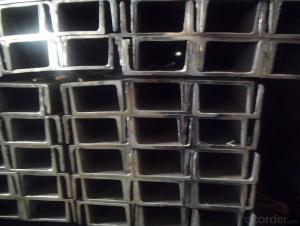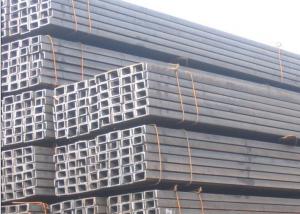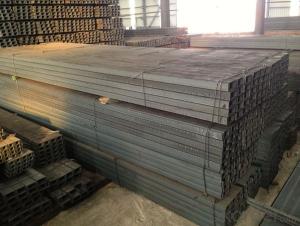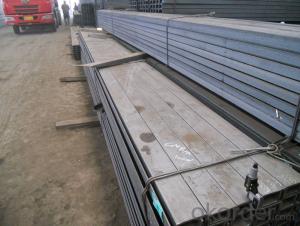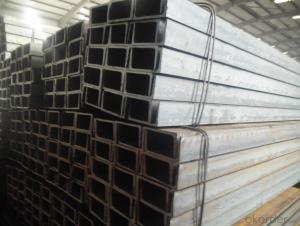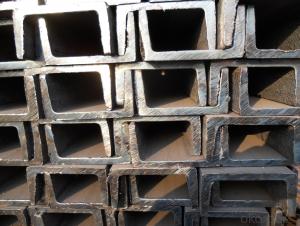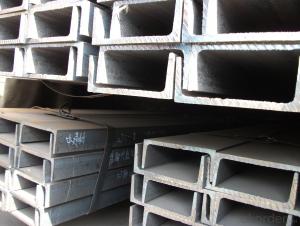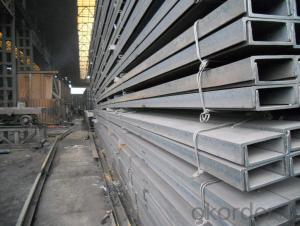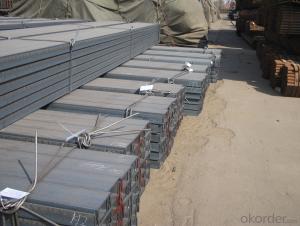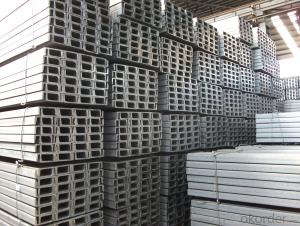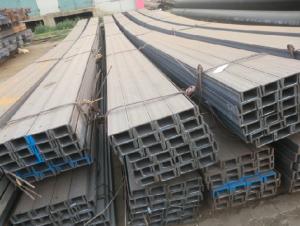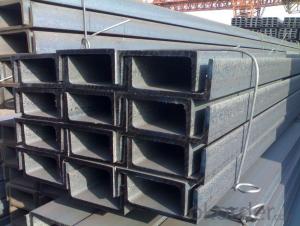GB Standard Hot Rolled Steel U Channels for Constrction
- Loading Port:
- Tianjin
- Payment Terms:
- TT OR LC
- Min Order Qty:
- 25 m.t.
- Supply Capability:
- 200000 m.t./month
OKorder Service Pledge
OKorder Financial Service
You Might Also Like
pecifications of GB Standard Hot Rolled Steel U Channels for Constrction:
1.We provide chinese and japanese standard structure steel u channel for structure construction
2. The prices can be quoted on the theoretical weight or actual weight, just as customer's requriements.
3.Those material includes: Q235/SS400/ST37-2 Q345/ST5
4.The sections of GB Standard Structure Steel U Channel are as followings in the table-1:
GB U CHANNEL | Standard h | Sectional b | Dimension s | t | Mass: Kg/m |
(mm) | (mm) | (mm) | (mm) | ||
50X37 | 50 | 37 | 4.50 | 7.0 | 5.438 |
63X40 | 63 | 40 | 4.80 | 7.5 | 6.634 |
80x43 | 80 | 43 | 5.00 | 8.0 | 8.045 |
100x48 | 100 | 48 | 5.30 | 8.5 | 10.007 |
120x53 | 120 | 53 | 5.50 | 9.0 | 12.059 |
140x58 | 140 | 58 | 6.00 | 9.5 | 14.535 |
140x60 | 140 | 60 | 8.00 | 9.5 | 16.733 |
160x63 | 160 | 63 | 6.50 | 10.0 | 17.240 |
160x65 | 160 | 65 | 8.50 | 10.0 | 19.752 |
180x68 | 180 | 68 | 7.00 | 10.5 | 20.174 |
180x70 | 180 | 70 | 9.00 | 10.5 | 23.000 |
200x73 | 200 | 73 | 7.00 | 11.0 | 22.637 |
200x75 | 200 | 75 | 9.00 | 11.0 | 25.777 |
220x77 | 220 | 77 | 7.00 | 11.5 | 24.999 |
220x79 | 220 | 79 | 9.00 | 11.5 | 28.453 |
250x78 | 250 | 78 | 7.00 | 12.0 | 27.410 |
250x80 | 250 | 80 | 9.00 | 12.0 | 31.335 |
250x82 | 250 | 82 | 11.00 | 12.0 | 35.260 |
280x82 | 280 | 82 | 7.50 | 12.5 | 31.427 |
280x84 | 280 | 84 | 9.50 | 12.5 | 35.823 |
280x86 | 280 | 86 | 11.50 | 12.5 | 40.219 |
300x85 | 300 | 85 | 7.50 | 13.5 | 34.463 |
300x87 | 300 | 87 | 9.50 | 13.5 | 39.173 |
300x89 | 300 | 89 | 11.50 | 13.5 | 43.883 |
Table-1
Note: we are also competent to supply structure steel u channel as per other sections, which depends on the customer's requirements for the quantity.
5.The chemical composition of structure steel u channel as shown in the table-2:
Alloy No | Grade | Element(%) | ||||
C | Mn | S | P | Si | ||
Q235 | B | 0.12-0.20 | 0.3-0.7 | ≦0.045 | ≦0.045 | ≦0.3 |
Table-2
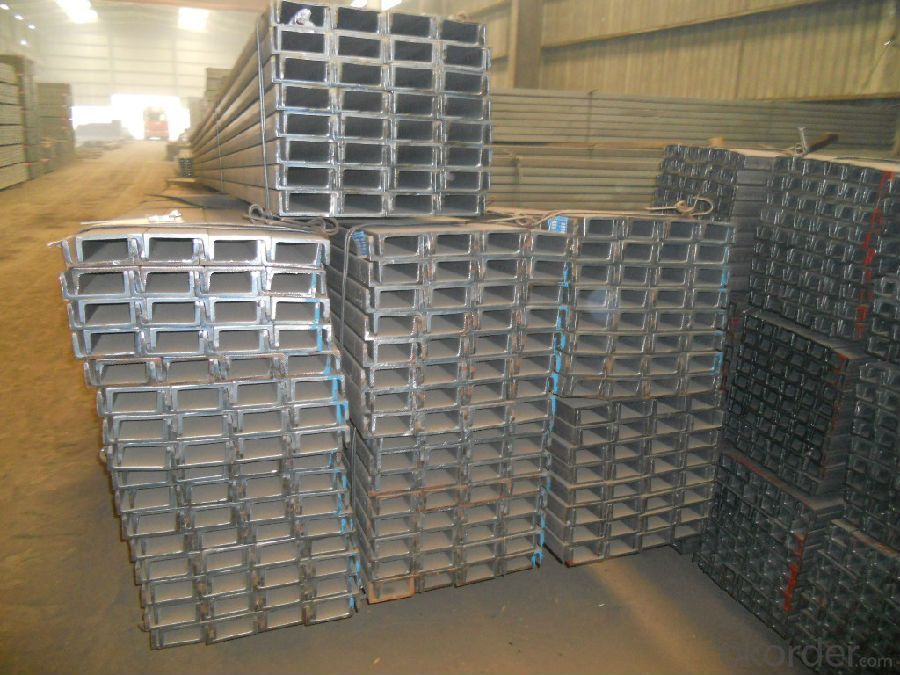
Applications of GB Standard Hot Rolled Steel U Channels for Constrction:
1.Character: The Structure Steel U Channel belongs to carbon structural steel which is applied to in the field of construction and machinery.
2.The structure steel u channel is usually used for architectural structure, and they could be welded in order to support or hang a variety of facilities. They are usually used in combination with I beam.
3.Generally, the structure steel u channel must possess perfect welding property,riveting property as well as mechanical property.
Package & Delivery of GB Standard Hot Rolled Steel U Channels for Constrction:
The structure steel u channel will be packed in bundle with steel wire at each end of every bundle and color marking in order to help the customer to recognize his goods more easily at sight.
And structure steel u channel could be loaded into 20ft or 40ft container, or by bulk cargo.If the weight of each bundle reaches less than 3.5 mt, the loading by break bulk cargo should be choosed.When the weight of each bundle reaches less than 3mt, the loading by container should be choosed.
As for the transportaion from mill to loading port, the truck will be usually used. And the maximum quantity for each truck is 40mt.
All in all, we could do in accordance with customer's request.
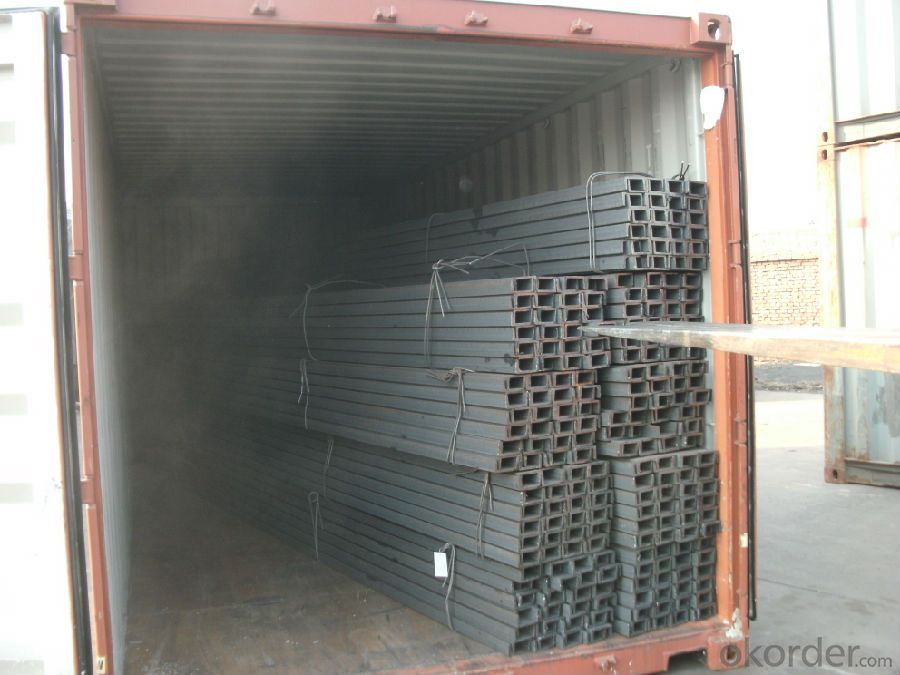
- Q: What are the different methods of protecting steel channels from impact damage?
- There are various methods of protecting steel channels from impact damage, including installing protective barriers or bollards, using impact-resistant coatings or paints, implementing cushioning materials or padding, employing shock-absorbing devices or systems, and reinforcing the structure with additional supports or reinforcements.
- Q: Can steel channels be used for creating staircases or handrails?
- Yes, steel channels can be used for creating staircases or handrails. Steel channels are versatile and strong, making them an ideal choice for constructing staircases and handrails. They provide structural support and stability, ensuring the safety of individuals using the stairs or handrails. Steel channels can be easily fabricated and customized to fit specific design requirements, making them suitable for various architectural styles. Additionally, steel channels are durable and resistant to wear and tear, making them a long-lasting option for staircases and handrails.
- Q: You can use steel purlin
- It is better not to use C steel. The channel steel made of 1.2--3.0MM is too heavy and the price is high
- Q: Are steel channels suitable for use in warehouse storage systems?
- Indeed, warehouse storage systems can make effective use of steel channels. Steel channels offer a robust and enduring structure that can bear the weight of heavy loads within a warehouse. They possess the capability to withstand the pressure generated by diverse storage items, and can be employed in various storage arrangements, including pallet racking systems, shelving units, or mezzanine platforms. Steel channels exhibit resistance to harm, corrosion, and wear, thereby guaranteeing an extended lifespan for the storage system. Moreover, they can be conveniently personalized and altered to suit different storage requirements and configurations, rendering them a flexible option for warehouse storage systems.
- Q: How do steel channels compare to other building materials?
- Steel channels are highly regarded in the construction industry due to their exceptional strength, durability, and versatility. Compared to other building materials like wood or concrete, steel channels offer superior resistance to fire, corrosion, and pests. They also have a higher load-bearing capacity, allowing for greater design flexibility and the ability to construct larger and more complex structures. Additionally, steel channels are known for their consistency in quality and precision, making them a preferred choice for many builders and architects.
- Q: How do steel channels contribute to the stability of bridges?
- Steel channels contribute to the stability of bridges by providing structural support and distributing the weight of the bridge evenly. They are used as beams or girders in bridge construction to resist bending and torsion forces, ensuring the bridge can withstand heavy loads and external forces without collapsing. The channels also help in maintaining the overall stability and integrity of the bridge, making it more durable and safe for transportation.
- Q: How do steel channels perform in high-vibration environments?
- Steel channels are renowned for their exceptional strength and durability, rendering them suitable for a multitude of applications, including those in high-vibration environments. In such settings, steel channels perform exceptionally well owing to their inherent properties. First and foremost, the high tensile strength of steel channels allows them to withstand substantial vibration forces without distorting or fracturing. This strength plays a pivotal role in high-vibration environments, where constant movement and mechanical stress are prevalent. The robust nature of steel channels ensures their effective handling of vibrations. Moreover, steel channels possess superb damping characteristics, enabling them to absorb and dissipate energy from vibrations. This attribute aids in minimizing the impact of vibrations on the overall structure or equipment. By reducing the magnitude of vibrations, steel channels contribute to maintaining stability and averting potential damage or failures. Additionally, steel channels can be tailored and manufactured to meet specific requirements, facilitating customization based on the intensity and frequency of vibrations. This design flexibility empowers engineers to select appropriate dimensions, cross-sections, and configurations to optimize the performance of steel channels in high-vibration environments. Furthermore, steel channels exhibit high resistance to corrosion, which is particularly crucial in surroundings where moisture, chemicals, or other corrosive agents may be present. Corrosion can undermine the structural integrity of any material, but steel channels manage to retain their strength and performance even in adverse conditions and over extended periods. In conclusion, steel channels are highly suitable for high-vibration environments due to their high tensile strength, excellent damping characteristics, design flexibility, and corrosion resistance. These attributes render steel channels a dependable and efficient choice for applications in industries such as construction, infrastructure, transportation, and manufacturing, where high-vibration environments are prevalent.
- Q: Can steel channels be used for staircases?
- Yes, steel channels can be used for staircases. Steel channels are often used as stringers, which are the structural supports for stairs. They provide strength, durability, and stability to the staircase, making them a popular choice in modern architectural designs.
- Q: What is the weight per meter of different steel channel sizes?
- The weight per meter of different steel channel sizes can vary depending on the specific dimensions and thickness of the channels. Steel channels are typically measured by their height, width, and thickness. To calculate the weight per meter, you would need to know the dimensions and density of the specific type of steel being used. The weight per meter can be calculated by multiplying the cross-sectional area of the channel by the density of the steel. For example, let's assume we have a steel channel with dimensions of 100mm (height) x 50mm (width) x 6mm (thickness), and the density of the steel is 7.85 grams per cubic centimeter (g/cm³). First, let's convert the dimensions to meters: Height = 100mm = 0.1m Width = 50mm = 0.05m Thickness = 6mm = 0.006m Next, calculate the cross-sectional area: Area = Height x Width = 0.1m x 0.05m = 0.005 square meters (m²) Finally, calculate the weight per meter: Weight per meter = Area x Thickness x Density = 0.005m² x 0.006m x 7.85g/cm³ = 0.0002355 kg/m So, for a steel channel with dimensions of 100mm x 50mm x 6mm, the weight per meter would be approximately 0.0002355 kg/m. It is important to note that this calculation is just an example and the weight per meter will vary depending on the specific dimensions and density of the steel being used.
- Q: Can steel channels be used for creating support structures for ventilation systems?
- Yes, steel channels can be used for creating support structures for ventilation systems. Steel channels are known for their strength and durability, making them suitable for providing the necessary support for ventilation systems. They can effectively hold the weight of the ductwork and ensure stability and longevity of the system.
Send your message to us
GB Standard Hot Rolled Steel U Channels for Constrction
- Loading Port:
- Tianjin
- Payment Terms:
- TT OR LC
- Min Order Qty:
- 25 m.t.
- Supply Capability:
- 200000 m.t./month
OKorder Service Pledge
OKorder Financial Service
Similar products
Hot products
Hot Searches
Related keywords
